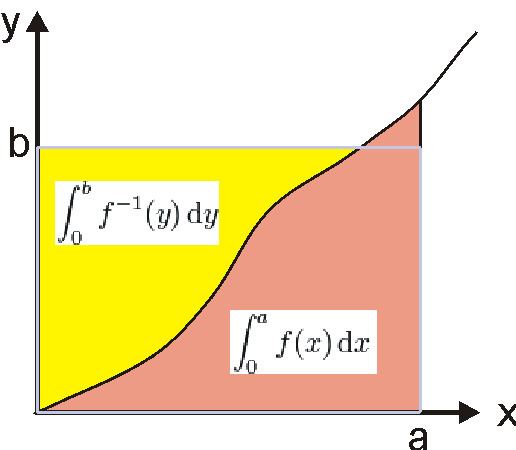 | ||
In mathematics, Young's inequality is either of two inequalities: one about the product of two numbers, and one about the convolution of two functions. They are named after William Henry Young.
Contents
- Standard version for conjugate Hlder exponents
- Elementary case
- Matricial generalization
- Standard version for increasing functions
- Generalization using Fenchel Legendre transforms
- Examples
- Youngs inequality for convolutions
- References
Young's inequality for products can be used to prove Hölder's inequality. It is also used widely to estimate the norm of nonlinear terms in PDE theory, since it allows one to estimate a product of two terms by a sum of the same terms raised to a power and scaled.
Standard version for conjugate Hölder exponents
In its standard form, the inequality states that if a and b are nonnegative real numbers and p and q are positive real numbers such that 1/p + 1/q = 1, then
The equality holds if and only if ap = bq. This form of Young's inequality is a special case of the inequality of weighted arithmetic and geometric means and can be used to prove Hölder's inequality.
Elementary case
An elementary case of Young's inequality is the inequality with exponent 2,
which also gives rise to the so-called Young's inequality with ε (valid for every ε > 0), sometimes called the Peter–Paul inequality. This name refers to the fact that tighter control of the second term is achieved at the cost of losing some control of the first term – one must "rob Peter to pay Paul"
Matricial generalization
T. Ando proved a generalization of Young's inequality for complex matrices ordered by Loewner ordering. It states that for any pair A, B of complex matrices of order n there exists a unitary matrix U such that
where * denotes the conjugate transpose of the matrix and
Standard version for increasing functions
For the standard version of the inequality, let f denote a real-valued, continuous and strictly increasing function on [0, c] with c > 0 and f(0) = 0. Let f−1 denote the inverse function of f. Then, for all a ∈ [0, c] and b ∈ [0, f(c)],
with equality if and only if b = f(a).
Generalization using Fenchel-Legendre transforms
If f is a convex function and its Legendre transform (convex conjugate) is denoted by g, then
This follows immediately from the definition of the Legendre transform.
More generally, if f is a convex function defined on a real vector space
where
Examples
Young's inequality for convolutions
In real analysis, the following result is also called Young's inequality:
Suppose f is in Lp(Rd) and g is in Lq(Rd) and
with 1 ≤ p, q, r ≤ ∞. Then
Here the star denotes convolution, Lp is Lebesgue space, and
denotes the usual Lp norm.
An example application is that Young's inequality can be used to show that the heat semigroup is a contracting semigroup using the L2 norm (i.e. the Weierstrass transform does not enlarge the L2 norm).
In case p, q > 1 Young's inequality can be strengthened to a sharp form, via
where the constant cp,q < 1.
